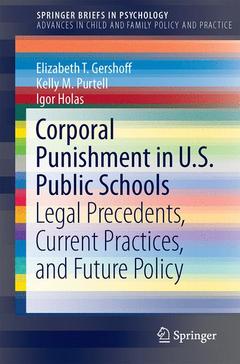Corporal Punishment in U.S. Public Schools, 2015 Legal Precedents, Current Practices, and Future Policy Advances in Child and Family Policy and Practice Series
Auteurs : Gershoff Elizabeth T., Purtell Kelly M., Holas Igor

Elizabeth Gershoff, Ph.D., is an associate professor of Human Development and Family Sciences and a faculty associate and postdoctoral training director at the Population Research Center, both at the University of Texas at Austin. She is a developmental psychologist who studies child and adolescent development in the context of families, schools, neighborhoods, and public policies. She is an internationally recognized expert in the effects of parents’ use of corporal punishment on children.
Kelly Purtell, Ph.D., is an assistant professor in the Department of Human Sciences at The Ohio State University who studies how economic disadvantage influences health and development across the lifespan. In particular, her research focuses on how contextual factors shape development among low-income children and adolescents, and how public policies can enhance the developmental trajectories of these youth.
Igor Holas, M.A., is a graduate student interested in links between education policy generally and state and local education funding in particular on the academic success of children and adolescents. He is the founder of Mentegram, an online tool for therapists and clinicians to track patient progress.
Reviews the history of corporal punishment in U.S. public schools to establish past and current prevalence
Explores what is known to date about the effects of school corporal punishment on children
Examines the effect of state-level school corporal punishment bans on trends in juvenile crime
Discusses potential legal, policy, and advocacy avenues for abolition of school corporal punishment at the state and federal levels
Includes supplementary material: sn.pub/extras
Date de parution : 02-2015
Ouvrage de 109 p.
15.5x23.5 cm
Thèmes de Corporal Punishment in U.S. Public Schools :
Mots-clés :
Corporal punishment at school; Disability status and school corporal punishment; Education policy and corporal punishment; Gender and school corporal punishment; Juvenile crime and school corporal punishment; Legal basis for school corporal punishment; Office for Civil Rights and school corporal punishment; Paddling at school; Parents and school corporal punishment; Physical abuse at school; Physical punishment at school; Race and school corporal punishment; School violence and corporal punishment; State edu



